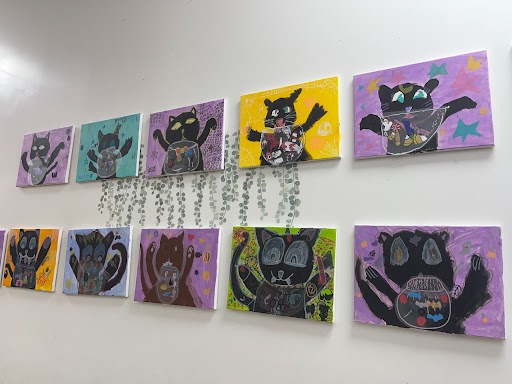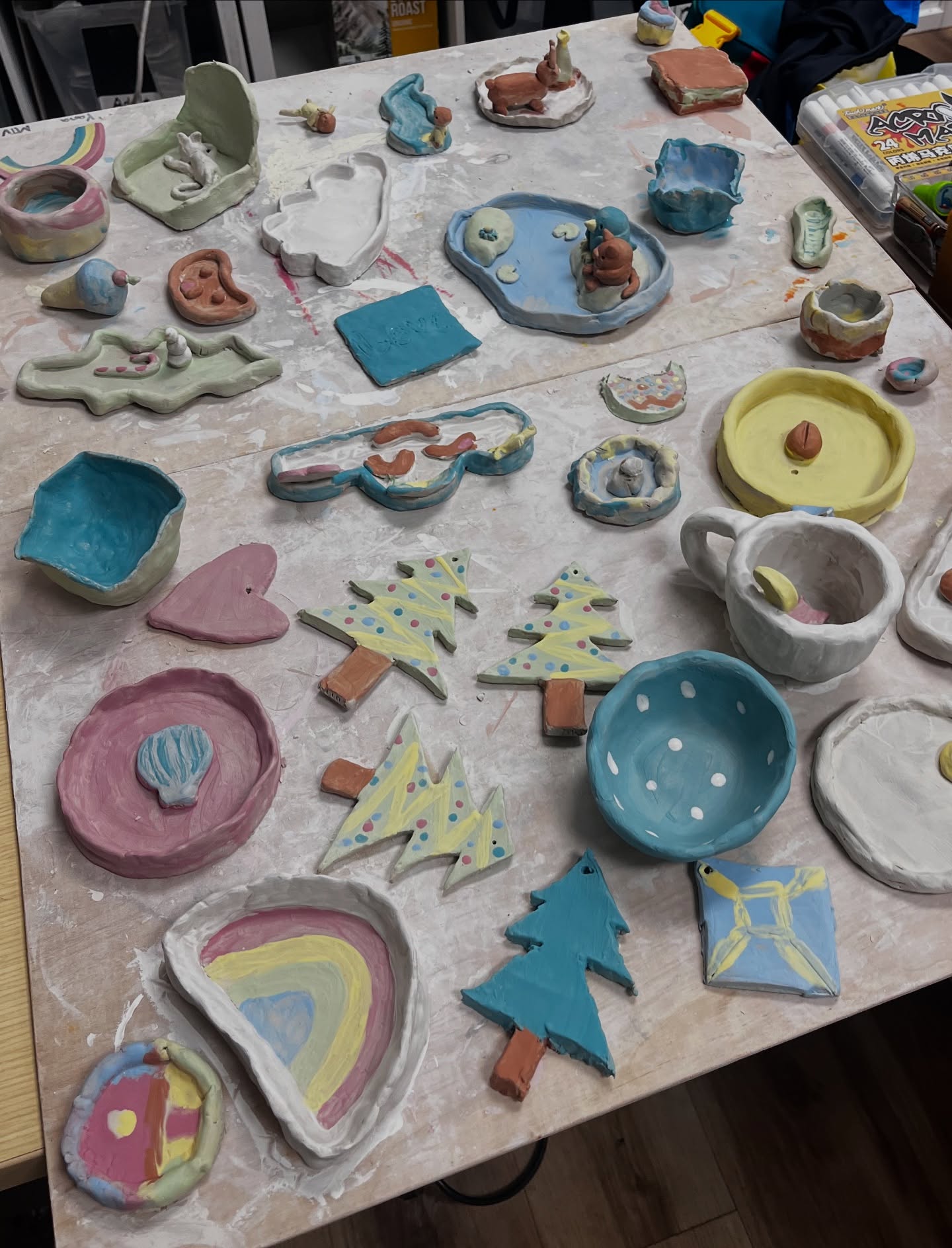An Artistic Summer to Renew Kids’ Life: 4 Key Logics Reveal the Value of Art Camps

A top-notch summer camp for kids is like a magical world, when time seems to be folded into each joyful moment. Here, kids can dive into their crafts and exploration, losing track of time as they immerse in what they love. It's a place where learning happens through play and skills improve almost without notice.
For parents, such a camp is a trusted place where they can safely leave their precious ones. They anticipate more than just knowledge and joy for their children; they want them to learn independence, problem-solving, and to grow into compassionate, responsible global citizens.

With all these expectations in mind, we've thoughtfully designed our summer camp curriculum, considering factors such as age groups, individual personalities, interests, and needs. We aim to infuse fun into serious learning, blending modern energy with the richness of history, and fostering both cognitive and hands-on skills.To build this dream camp, our dedicated teachers have tirelessly brainstormed, held numerous meetings, and tested after class. Their relentless efforts have shaped our camp's blueprint.
In this article, we'll explore four key logic relationships that determine the true value of an art summer camp, which also serve as the fundamental tenets underlying our curricular design.

1【Global Culture vs. Self-Cognition】
Representative camps:
- Amusement Park Funtime (5~6 yo EXP Camp)
- Let’s Travel! Adventures in the Australian Outbacks! (5~6 yo EXP Camp)
- Voyage Through Hawaiian Islands: Tiki Tales, Polynesian Art & Culture (7~9 yo FND Camp)
- Travel Book Camp(10~14 yo Digital Camp)




The idea "The world is so big, I want to see it" is no longer just a distant dream for kids but growing reality. While nothing can fully replace the experience of physical travel and on-site exploration, art offers a window to explore global cultures right from home, offering both cost-effectiveness and meaning. Unlike quick glances during trips, creating art helps kids really connect with and understand different cultures deeply.
In our art education, we blend in cultures from all around the world. Teachers explain global cultures in details, and kids get to bring these cultures to life through their own art. This hands-on experiences helps them truly appreciate and understand various cultural nuances, fostering deep empathy and understanding towards people from all walks of life. Early education is the key to develop kids' values and worldview, and exploring different cultures can teach kids to be more inclusive and respectful, preparing them to be global citizens.
.png)
In a globalized world, cross-cultural communication skills are essential in the workplace. Appreciating and respecting different cultural backgrounds through art education is invaluable in diverse work environments. Businesses and educational institutions increasingly prefer individuals with broad cultural perspectives and sensitivity, making this skill an advantage for children's future careers and higher education.
Most importantly, understanding other cultures helps kids on their own journey of self-discovery and self-awareness. They build their own identity by interacting with the world. By deeply engaging and thinking about art and cultures from other countries, kids not only learn about the world but also gain a clearer sense of who they are and what they value, embracing their own uniqueness.

2【Following History vs. Igniting New Knowledge】
Representative camps:
- Masterpieces vs. Popular Culture(5~6 yo EXP Camp)
- Journey Through Art History & Masterpieces(7~9 yo FND Camp)
- My imaginary world watercolor illustration inspired by famous artist (10~12 yo ADV Camp)
- Still Life Drawing Camp (inspired by artist Avigdor Arikha) (12+ Teen Camp)




We truly believe in the immense values of learning from the masterpieces and life journeys of great artists. That's why we've designed our curriculum with rich art history content. History has shown us that art learning often took place within the mentorship between a master and an apprentice, who absorbed knowledge and inspiration under teacher’s guidance. This legacy is more than just passing down skills; it's about igniting the torch of inspirations and ideas that illuminate the path of an artist's growth.
Art history is a long story made up of many artists' work and thoughts. It shows how art has changed over time and reflects the culture and ideas of different periods. Introducing art history into children's education aims to provide deeper understanding, a more historically enriched learning environment, helping students to connect art with culture and ideas.

How should we study masters and art history? In exploring art history and its great creators, we adopt a respectful yet questioning academic attitude and education strategies that feature innovation.
First, art history and masterpieces carry a timeless quality. Every re-visit to historical artworks unveils new meanings and values, ensuring the transmissions and evolution of art remains vibrant with the infusion of new ideas and spirits.
Exploration is the key to learning. With a deeper understanding of masterpieces as a foundation, we encourage kids to develop their own perspectives and interpretations, teaching them to view art from various angles. This fosters critical thinking and independent thinking. A major innovation in our curriculum is blending contemporary popular culture with traditional art history, creating a platform for understanding the relevance of traditional art in modern contexts and encouraging active personal expression in the process.

3 【Standing in Reality vs. looking at the Stars】
Representative camps:
- Little Time Travelers(5~6 yo EXP Camp)
- Futuristic World Building & City Design (7~9 yo FND Camp)
- Fantasy Camp (10~14 yo Digital Camp)
- Game Art: Fantasy City Design (10~12 yo ADV Camp)




For kids of all ages, the magic of fairy tales, fantasies, si-fi, and adventures in art and literature is undeniable. This magic fosters children's imagination and creativity, offering them a spirit of adventure away from the monotony of daily life, uniquely enhancing their cognitive, emotional, and social skills.
In our summer camp, we offer kids a spaceship ticket to a realm of boundless imaginations, where fantasy fuels creativity.Here, imagination is the essence of creation, spanning the cosmic expanses, the mystical depths of the oceans, and the boundless frontiers of the future.

We believe that in the vast universe of art, precise realism and keen observation of life form the foundation of artistic expressions. However, the essence of art lies in its ability to break free from the confines of reality, pursuing dreams and fantasies unreachable in the physical world through visual language.
Therefore, our summer camp curriculum is meticulously designed to find a balance between nurturing the children's artistic foundation and sparking their imaginative power. We inspire the kids to infuse their boundless imaginations into traditional art forms such as painting and sculpture. This educational strategy not only aims to provide children with a fundamental understanding of artistic expressions but also encourages them to unleash their creative potential with enthusiasm and proactivity.

4【Flat Canvas vs. Multi-Dimensional Life】
Representative camps:
- Let’s Travel! Adventures in the Australian Outbacks pop-up-art! (5~6 yo EXP Camp)
- Minecraft Inspired World Building (7~9 yo FND Camp)
- From 3D to 2D: exploring forms and shadows in pencil shading (10~12 yo ADV Camp)
- Plein Air Sketchbook and video making Camp(12+ Teen Camp)




Exploring the vast world of art, the journey from 2D drawings and paintings to 3D creations opens up a multi-dimensional and multi-media creative space for kids. This shift from flat to spatial is a comprehensive challenge and exercise for various skills.
In 2D art, children use their pencils and brushes on paper, to master composition, color blending, and the harmony of lines and shapes, enhancing their abilities to abstract and simplify the world around them. This nurtures their visual thinking and aesthetic appreciation, enabling them to weave vast narratives with minimal elements.

Moving to 3D art allows kids to bring their imaginations to tangible objects, like sculptures or crafts. They consider shape, structure, and material, translating abstract ideas into real objects, enhancing their spatial awareness, manual dexterity, and mind-hand coordination.
Both 2D and 3D artistic creations profoundly influence children's cognitive growth and inventive thinking. An effective art summer camp encourages detailed exploration on paper while also unlocking their potential to experiment with materials, spaces, and the tangible aspects of art.



Discover the Best Art Classes in Fremont for Kids

5 Reasons to Enroll Your Child in a Children’s Art Class Today

10 Reasons Why an Art Class for Kids Boosts Creativity and Confidence

How a Children’s Art Class Can Inspire Lifelong Passion?

Unlock Your Child’s Creativity with Art Classes in Belmont

How Does a Children’s Art Class Help with Emotional Development?

How Does an Art Class for Kids Boost Creativity and Confidence?

What Should You Look for When Choosing Art Classes in Mountain View?

What Makes Fremont Art Classes So Popular in 2025?

2025 IAMA Youth Art Contest and Exhibition
Unlock Your Child’s Artistic Potential: Finding the Right Art Class for Kids

Artistic Eyes: Exploring the Secrets of Composition

8/10 CalColor Open House tryout Classes Invitation

Teen Boot Camp: The Winning Strategy for College Applications

An Artistic Summer to Renew Kids’ Life: 4 Key Logics Reveal the Value of Art Camps

Brush of the Future: How Digital Art Empowers Children's Path to College and Career

Summer Camp Carnival: A Must-Attend Artistic Feast for All Ages

The Dream of Art, The Journey of a Year: CalColor 2023 Year-End Summary

How to Visit an Art Museum – A Guide for Families

Rising from Scratch: The Remarkable Journey of CalColor Teen Program

Changing Perspectives: How Art Transforms Students' Views of the Everyday
CalColor Academy's younger students recently explored car interiors. Students typically draw the outside of cars, but we asked them to focus on the details of dashboards, steering wheels, and AC vents. Different age groups used various techniques: younger students focused on basic shapes and one-point perspective, while older students honed advanced skills like hand drawing and shadow incorporation. These projects highlighted how art can change our perspective, revealing the extraordinary in the every day, a valuable lesson for our students on their artistic journeys.

Dawning Realism
When kids reach middle school and high school age, they become more advanced in their understanding of value, shape, proportion, and want to stretch their ability to mimic real life.





